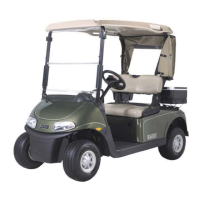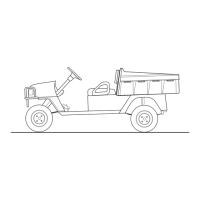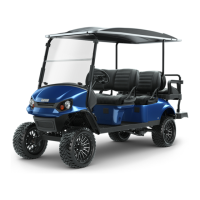OPERATION AND SERVICE INFORMATION
Page 9
Owner’s Manual and Service Guide
Read all of Manual to become thoroughly familiar with this vehicle. Pay particular attention to all Notes, Cautions and Warnings
caused by a broken socket when remov-
ing wheels, use only sockets designed
for impact wrench use.
Use caution when inflating tires. Overin-
flation could cause the tire to separate
from the wheel or cause the tire to
explode, either of which could cause
severe injury.
Use caution when inflating tires. Due to the low volume of
the small tires, overinflation can occur in seconds. Over-
inflation could cause the tire to separate from the wheel
or cause the tire to explode.
Tire inflation should be determined by the condition of the
terrain. See GENERAL SPECIFICATIONS section for
recommended tire inflation pressure. For outdoor appli-
cations with major use on grassy areas, the following
should be considered. On hard turf, it is desirable to have
a slightly higher inflation pressure. On very soft turf, a
lower pressure reduces the possibility of tires cutting into
the turf. For vehicles being used on paved or hard sur-
faces, tire inflation pressure should be in the higher
allowable range, but under no condition should inflation
pressure be higher than recommended on tire sidewall.
All four tires should have the same pressure for opti-
mum handling characteristics. Be sure to install the valve
dust cap after checking or inflating.
The vehicle is fitted with low pressure tubeless tires
mounted on one piece rims; therefore, the most cost
effective way to repair a puncture in the tread is to use a
commercial tire plug.
Tire plug tools and plugs are available at most
automotive parts outlets and have the advan-
tage of not requiring the tire be removed from the wheel.
If the tire is flat, remove the wheel and inflate the tire to
the maximum recommended pressure for the tire.
Immerse the tire in water to locate the leak and mark with
chalk. Insert tire plug in accordance with manufacturer’s
instructions.
To reduce possibili-
ty of severe injury,
be sure mounting/
demounting machine is anchored to floor.
Wear OSHA approved safety equipment
when mounting/demounting tires.
If the tire is to be removed or mounted, the tire changing
machine manufacturer’s recommendations must be fol-
lowed in order to reduce possibility of severe injury.
Wheel Installation
To reduce the possibility of com-
ponent damage, do not tighten
lug nuts to more than 85 ft. lbs. (115 Nm) torque.
It is important to follow the ‘cross sequence’
pattern when installing lug nuts. This will
assure even seating of the wheel against the hub.
With the valve stem to the outside, mount the wheel onto
the hub with lug nuts. Finger tighten lug nuts in a ‘cross
sequence’ pattern (Ref Fig. 10 on page 9) . Tighten lug
nuts to 50 - 85 ft. lbs. (70 - 115 Nm) torque in 20 ft. lbs.
(30 Nm) increments following the ‘cross sequence’ pat-
tern.
HEADLIGHT REPLACEMENT
For vehicles with headlights mounted in cowl, locate the
two screws on backside of cowl that secure headlight
(Ref Fig. 11 on page 9). Remove screws, pull headlight
out and disconnect wires. Connect wires to new head-
light, install in cowl and secure with screws previously
removed.
FUSE REPLACEMENT
To replace fuses, locate the fuse block under the driver
side seat. Pull out old fuse and replace with a new auto-
motive type fuse. Headlights and fuses are available
Fig. 10 Wheel Installation
Fig. 11 Headlight Replacement
Tire style
may vary
1
2
3
4
'Cross Sequence'
Ref Whi 1
Headlight
Bulb
of Cowl

